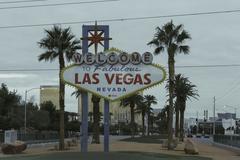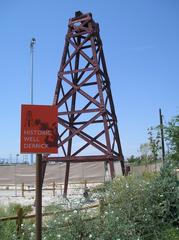Complete Guide to Visiting Old Las Vegas Fort State Historical Park, Las Vegas, United States
Date: 19/07/2024
Introduction
Old Las Vegas Fort State Historical Park, often known as the Las Vegas Mormon Fort, stands as a significant historical landmark in the Las Vegas Valley. Established in 1855 by Mormon missionaries led by William Bringhurst, it holds the distinction of being the oldest non-native structure in the area. This historic site provides a fascinating glimpse into the early history and development of Las Vegas, highlighting the resilience and ingenuity of the settlers who braved the harsh Mojave Desert to establish a community (Nevada State Parks). The fort originally served as a waystation on the Old Spanish Trail, connecting Santa Fe to Los Angeles, and played a crucial role in the region’s trade and travel (National Park Service).
Today, the Old Las Vegas Fort offers visitors an opportunity to explore the rich cultural and historical tapestry of the region. From its adobe brick construction to its central courtyard, the fort’s architecture reflects the practical needs of its early inhabitants, providing both protection and community space. The fort’s history also encompasses its role in the broader context of American expansion westward, including its conversion into a ranching operation and its eventual decline and preservation efforts in the 20th century (Desert USA). Whether you’re a history enthusiast or a casual visitor, the park’s educational programs, guided tours, and cultural events offer a comprehensive and engaging experience that brings the past to life.
Table of Contents
- [History of Old Las Vegas Fort State Historical Park](#history-of-old-las-vegas-fort-state-historical-parkhistory-of-old-las-vegas-fort-state-historical-park)
- [Early Beginnings](#early-beginningsearly-beginnings)
- [Construction and Layout](#construction-and-layoutconstruction-and-layout)
- [The Mormon Mission](#the-mormon-missionthe-mormon-mission)
- [Post-Mormon Era](#post-mormon-erapost-mormon-era)
- [20th Century and Preservation Efforts](#20th-century-and-preservation-efforts20th-century-and-preservation-efforts)
- [Historical Significance](#historical-significancehistorical-significance)
- [Archaeological Discoveries](#archaeological-discoveriesarchaeological-discoveries)
- [Visitor Information](#visitor-informationvisitor-information)
- [Ticket Prices and Visiting Hours](#ticket-prices-and-visiting-hoursticket-prices-and-visiting-hours)
- [Travel Tips](#travel-tipstravel-tips)
- [Educational and Cultural Programs](#educational-and-cultural-programseducational-and-cultural-programs)
- [Visitor Experience](#visitor-experiencevisitor-experience)
- [Nearby Attractions](#nearby-attractionsnearby-attractions)
- [Neon Museum](#neon-museumneon-museum)
- [Fremont Street Experience](#fremont-street-experiencefremont-street-experience)
- [Las Vegas Natural History Museum](#las-vegas-natural-history-museumlas-vegas-natural-history-museum)
- [FAQ](#faqfaq)
- [Conclusion](#conclusionconclusion)
- [References](#referencesreferences)
History of Old Las Vegas Fort State Historical Park
Early Beginnings
Old Las Vegas Fort State Historical Park, also known as the Las Vegas Mormon Fort, holds the distinction of being the oldest non-native structure in the Las Vegas Valley. The fort was established in 1855 by Mormon missionaries led by William Bringhurst. The site was strategically chosen due to its proximity to the Las Vegas Springs, a vital water source in the arid Mojave Desert. The fort served as a waystation for travelers on the Old Spanish Trail, a trade route connecting Santa Fe, New Mexico, to Los Angeles, California (Nevada State Parks).
Construction and Layout
The original fort was constructed using adobe bricks, a common building material in the Southwest due to its insulating properties. The structure included a central courtyard surrounded by high walls, with rooms for living quarters, storage, and defense. The fort’s design reflected the practical needs of the settlers, providing protection against potential threats and a communal space for daily activities. The fort’s walls were approximately 14 feet high and 2 feet thick, offering substantial defense against both human and environmental challenges (National Park Service).
The Mormon Mission
The primary objective of the Mormon settlers was to establish a mission and convert the local Paiute population to Christianity. However, the mission faced numerous challenges, including harsh environmental conditions, limited resources, and cultural differences with the Paiute people. Despite these difficulties, the settlers managed to cultivate crops and establish a modest community. The mission, however, was short-lived; by 1857, the settlers abandoned the fort due to internal conflicts and the recall of the missionaries by Brigham Young, the leader of the Mormon Church (Desert USA).
Post-Mormon Era
After the departure of the Mormon settlers, the fort saw various uses and occupants. In the late 19th century, it became a ranching operation under the ownership of Octavius Gass, who expanded the agricultural activities initiated by the Mormons. Gass renamed the area “Las Vegas Rancho” and played a significant role in the development of the Las Vegas Valley. However, financial difficulties led to Gass losing the property to Archibald Stewart in 1881. Stewart and his family continued to operate the ranch until his death in 1884 (Las Vegas Review-Journal).
20th Century and Preservation Efforts
The early 20th century saw the fort’s decline as Las Vegas began to grow rapidly due to the construction of the Hoover Dam and the legalization of gambling. The fort’s historical significance was recognized in the mid-20th century, leading to efforts to preserve and restore the site. In 1955, the fort was designated a Nevada State Park, and restoration projects were undertaken to stabilize the remaining structures and reconstruct parts of the original fort. These efforts aimed to provide visitors with a glimpse into the early history of Las Vegas and the challenges faced by its first settlers (Nevada State Parks).
Historical Significance
Old Las Vegas Fort State Historical Park serves as a tangible link to the early history of Las Vegas, offering insights into the region’s development and the diverse groups that contributed to its growth. The fort is a testament to the resilience and ingenuity of the early settlers who established a foothold in the harsh desert environment. It also highlights the complex interactions between different cultural groups, including the Mormon missionaries, local Paiute tribes, and later settlers and ranchers.
Archaeological Discoveries
Archaeological excavations at the site have uncovered artifacts that provide valuable information about the daily lives of the fort’s inhabitants. These findings include tools, pottery, and remnants of the original adobe structures. The artifacts offer a glimpse into the resourcefulness of the settlers and their ability to adapt to the challenging conditions of the Mojave Desert. The ongoing archaeological work at the site continues to shed light on the fort’s history and its role in the broader context of the American West (Nevada State Museum).
Visitor Information
Ticket Prices and Visiting Hours
- Visiting Hours: The visiting hours for Old Las Vegas Fort State Historical Park are from 8:00 AM to 4:30 PM, Monday through Saturday.
- Ticket Prices: Tickets cost $3 for adults and are free for children under 12 years old.
Travel Tips
- Getting There: The park is located in downtown Las Vegas, making it easily accessible by car, public transportation, or even on foot from nearby attractions.
- Best Time to Visit: The site can be visited year-round, but it is best to visit during the cooler months (October to April) to avoid the extreme heat of the summer.
- What to Bring: Comfortable walking shoes, a hat, sunscreen, and water are recommended, especially during warmer months.
Educational and Cultural Programs
Old Las Vegas Fort State Historical Park offers a range of educational programs and cultural events that aim to engage visitors with the site’s rich history. These programs include guided tours, historical reenactments, and workshops on traditional crafts and skills. The park also hosts events that celebrate the diverse cultural heritage of the region, providing a platform for community engagement and historical education. These initiatives help to preserve the legacy of the fort and ensure that its history remains accessible to future generations (Nevada State Parks).
Visitor Experience
Visitors to Old Las Vegas Fort State Historical Park can explore the reconstructed fort, view exhibits on the site’s history, and participate in interactive programs. The park’s visitor center offers detailed information on the fort’s history, including displays of artifacts and interpretive panels. The park’s staff and volunteers are knowledgeable and passionate about the site’s history, providing valuable insights and enhancing the visitor experience. The park’s location in downtown Las Vegas makes it easily accessible, offering a unique historical perspective amidst the modern urban landscape (Las Vegas Sun).
Nearby Attractions
Neon Museum
Just a short drive away, this museum showcases iconic Las Vegas signs (Neon Museum).
Fremont Street Experience
A pedestrian mall with a vibrant light show and entertainment (Fremont Street Experience).
Las Vegas Natural History Museum
Offers exhibits on dinosaurs, marine life, and more (Las Vegas Natural History Museum).
FAQ
What are the visiting hours for Old Las Vegas Fort?
- The visiting hours for Old Las Vegas Fort State Historical Park are from 8:00 AM to 4:30 PM, Monday through Saturday.
How much are tickets to Old Las Vegas Fort?
- Tickets cost $3 for adults and are free for children under 12 years old.
Conclusion
Old Las Vegas Fort State Historical Park is a vital historical site that offers a window into the early history of Las Vegas and the diverse groups that shaped its development. The fort’s preservation and educational programs ensure that its legacy continues to be appreciated and understood by visitors from around the world. Be sure to plan your visit to experience this unique piece of Las Vegas history firsthand (Las Vegas Review-Journal).
Whether you’re planning a visit during the cooler months to avoid the desert heat or taking part in one of the many educational programs and cultural events, Old Las Vegas Fort State Historical Park offers a unique and immersive historical experience. The ongoing preservation efforts and archaeological discoveries continue to shed light on the fort’s history, ensuring that its story remains an integral part of the American Southwest’s heritage. Plan your visit today to explore this remarkable site and immerse yourself in the stories of the past (Las Vegas Sun).
References
- Nevada State Parks, 2024, Nevada State Parks https://parks.nv.gov/parks/old-las-vegas-mormon-fort
- National Park Service, 2024, National Park Service https://www.nps.gov/places/old-las-vegas-mormon-fort.htm
- Desert USA, 2024, Desert USA https://www.desertusa.com/desert-nevada/las-vegas-mormon-fort.html
- Las Vegas Review-Journal, 2024, Las Vegas Review-Journal https://www.reviewjournal.com/local/local-las-vegas/las-vegas-mormon-fort-where-it-all-began-1533467/
- Las Vegas Sun, 2023, Las Vegas Sun https://lasvegassun.com/news/2023/jan/15/old-las-vegas-mormon-fort-state-historical-park/







